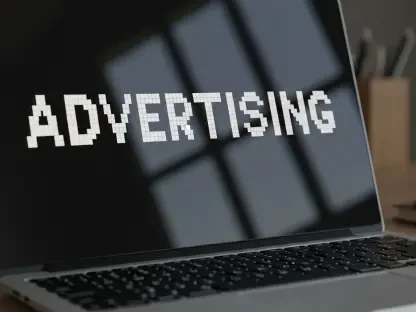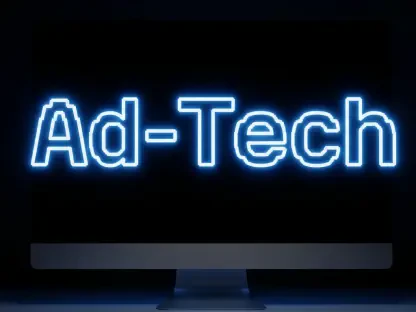Setting the Stage for a Digital Advertising Breakthrough
Imagine a world where television advertising no longer interrupts your favorite show but instead waits patiently for a natural break to capture your attention. This is the reality of Connected TV (CTV) advertising in 2025, where innovative formats are reshaping how brands connect with audiences. A striking example comes from jewelry retailer Zales, which achieved an astonishing 276% increase in QR code scans through a groundbreaking campaign. This remarkable feat raises a critical question: how can a simple pause in viewing transform into a powerful driver of consumer action? Delving into this case offers insights into the evolving dynamics of digital marketing and the potential of non-intrusive ad strategies to redefine engagement.
Understanding the CTV Advertising Landscape
The CTV advertising sector stands as a dominant force in digital marketing, experiencing rapid expansion as more households shift away from traditional cable. With millions of viewers embracing streaming platforms, CTV has become a vital channel for reaching cord-cutting audiences who prioritize on-demand content. This medium’s ability to deliver targeted messages in premium streaming environments positions it as a cornerstone of modern advertising strategies.
Significant growth in media budgets allocated to CTV underscores its importance, with projections estimating that its share will climb substantially in the coming years. Major platforms like Xumo Play and YouTube dominate the space, leveraging programmatic advertising to enhance precision and scale. Technological advancements, such as pause ads, further amplify CTV’s appeal by offering novel ways to engage viewers without disrupting their experience.
The market dynamics continue to evolve, driven by advertisers’ increasing confidence in CTV’s ability to deliver measurable results. As consumer habits tilt toward streaming, brands are reallocating resources to capitalize on this shift. This trend highlights the growing recognition of CTV as not just a supplementary channel but a primary avenue for impactful marketing campaigns.
Innovations and Trends in CTV Engagement
Emergence of Pause Advertising
Pause advertising has emerged as a game-changer in the streaming ecosystem, gaining traction across platforms like YouTube, Fubo, and DIRECTV. Unlike traditional ads that interrupt content, pause ads activate during natural viewing breaks, such as when a viewer hits the pause button. This non-intrusive approach respects the audience’s flow, presenting messages at moments when attention is already available.
The format’s strength lies in its alignment with viewer behavior, capitalizing on brief interludes to deliver concise, actionable content. For instance, displaying a QR code during a pause allows viewers to engage directly without feeling forced or annoyed. This method reflects a broader industry push toward advertising solutions that prioritize user experience while still achieving brand objectives.
As streaming continues to dominate media consumption, the demand for such user-first innovations grows. Pause ads meet this need by offering seamless integration into the viewing journey, ensuring that engagement does not come at the expense of satisfaction. Their rising adoption signals a shift in how platforms and advertisers approach audience interaction in premium digital spaces.
Performance Metrics and Market Growth
Data underscores the robust performance of CTV as a marketing channel, with a significant percentage of marketers planning to increase programmatic budgets in the near term. Industry insights reveal that 72% of advertisers intend to boost their investments, reflecting confidence in CTV’s superior targeting and engagement metrics. This momentum positions the medium for substantial growth over the next few years.
The financial commitment to CTV advertising is on a steep upward trajectory, with its share of media budgets expected to rise sharply from current levels. This surge is fueled by the platform’s ability to deliver precise audience segmentation and real-time optimization, outpacing traditional linear TV in efficiency. Innovative formats like pause ads play a pivotal role, as demonstrated by campaigns achieving exceptional outcomes in viewer response rates.
Looking ahead, the integration of advanced ad formats promises to further enhance CTV’s impact on marketing strategies. The ability to measure direct actions, such as QR scans leading to purchases, provides concrete evidence of return on investment. Such developments suggest that CTV will continue to redefine performance expectations, solidifying its place in the advertising hierarchy.
Challenges in CTV Advertising Adoption
Despite the promise of formats like pause ads, their widespread adoption faces notable hurdles. Technological integration remains a primary barrier, as diverse streaming platforms often operate on varying systems that complicate uniform implementation. Ensuring compatibility across devices and services requires significant investment and coordination from industry stakeholders.
Viewer resistance to advertising in streaming environments also poses a challenge, as audiences accustomed to ad-free experiences may react negatively to perceived intrusions. Balancing the frequency and placement of ads to maintain a positive user experience is critical, yet difficult, especially in a competitive landscape where satisfaction drives retention. Advertisers must navigate this delicate balance to avoid alienating their target demographics.
Potential solutions lie in strategic partnerships and real-time optimization capabilities that address scalability and targeting issues. Collaborating with technology providers and platforms can streamline deployment, while data-driven adjustments ensure ads reach the right viewers at optimal moments. Overcoming these obstacles will be essential for pause ads and similar innovations to achieve mainstream acceptance in the CTV space.
Strategic Partnerships and Technology in Zales’ Campaign
The success of Zales’ campaign hinged on a network of strategic collaborations that amplified its reach and effectiveness. Partnerships with WunderKIND Ads, Xumo Play, Connect at Publicis Media, and OpenGlass.TV created a robust framework for delivering pause ads at scale. Each collaborator brought unique expertise, from media planning to technical execution, ensuring a cohesive and impactful initiative.
WunderKIND’s pioneering programmatic pause ad technology stood out as a cornerstone of the campaign, enabling targeted delivery of QR code-enabled advertisements. This first-to-market solution allowed for precise audience segmentation and seamless integration into natural viewing breaks on Xumo Play’s platform. The result was a significant uptick in engagement, as viewers responded to tailored messages during opportune moments.
Measurement and attribution capabilities further enhanced the campaign’s value, providing clear insights into conversions from large-screen exposure to mobile transactions. Tracking QR scans through the purchase funnel offered actionable data, demonstrating the direct impact of pause ads on sales. Such precision in analytics underscores the importance of technology in validating CTV as a driver of tangible business outcomes.
Future Outlook for Pause Ads in CTV
Pause ads hold immense potential to become a standard feature in CTV advertising, given their alignment with viewer preferences for non-disruptive formats. Their ability to capture attention during organic pauses without interrupting content positions them as a sustainable option for brands seeking engagement. As platforms refine this approach, broader adoption seems likely in the near term.
Emerging technologies, such as advanced targeting algorithms and AI-driven optimization, could further elevate the effectiveness of pause ads. These tools promise to enhance personalization, ensuring that messages resonate with specific audience segments based on real-time data. Additionally, market disruptors may introduce new creative formats or delivery mechanisms, pushing the boundaries of what pause advertising can achieve.
The growing investment in CTV, coupled with shifting consumer streaming habits, will shape the trajectory of such innovations. Economic conditions globally may influence budget allocations, but the medium’s proven efficacy suggests resilience in advertiser commitment. As these factors converge, pause ads are poised to play a central role in the evolution of digital marketing strategies.
Reflecting on a Milestone in CTV Innovation
Looking back, Zales’ campaign marked a turning point in how CTV advertising is perceived and executed. The unprecedented 276% surge in QR code scans underscored the transformative power of pause ads, proving that strategic ingenuity could drive direct consumer action in a streaming context. This achievement challenged longstanding assumptions about CTV’s role, elevating it from a mere awareness tool to a conversion powerhouse.
For advertisers aiming to build on this success, actionable steps emerged from the initiative’s outcomes. Investing in programmatic solutions that enable precise targeting and real-time optimization became a clear priority, as did fostering partnerships with technology providers and platforms to ensure seamless delivery. These efforts could help replicate the impact seen in Zales’ campaign across diverse industries.
Beyond immediate tactics, a broader consideration surfaced around adapting to viewer expectations in an increasingly digital landscape. Exploring hybrid approaches that blend pause ads with other interactive formats might offer fresh avenues for engagement. As the industry moves forward, the lessons from this campaign encourage a mindset of innovation and collaboration, paving the way for future breakthroughs in connecting with audiences.









